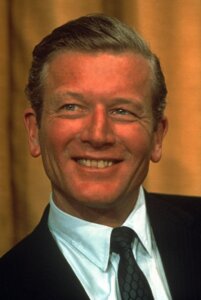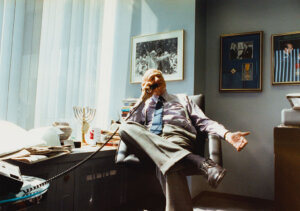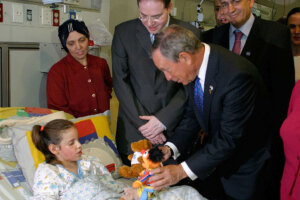Top row, left to right: Vincent Impellitteri, Michael Bloomberg, Abe Beame, John Lindsay;
Middle row: Robert Wagner Jr., William O’Dwyer, Eric Adams, Ed Koch;
Bottom Row: Ed Koch, Bill DeBlasio, David Dinkins, Rudy Giuliani Photo by Getty Images
For the past 75 years, every mayor of New York City has spent time getting to know Manhattan, Brooklyn, Queens, the Bronx, and Staten Island — and also Israel. The tradition began just after Israel’s founding as a way to show support both for the fledgling nation and for Jewish constituents at home.
But at the most recent NYC mayoral debate, when candidates were asked if they would visit Israel as mayor, all but Zohran Mamdani said they would, sparking curiosity among many (and confusion and outrage among others) about this tradition. “This s–t is so weird,” commented one indignant YouTube user, @Bogwogponk, on a video of Mamdani posted by NBC. “Why would the mayor of NYC need to visit Israel?”
Well, @Bogwogponk, you have not asked in vain: Since 1951, when William O’Dwyer, who served as mayor of New York from 1946 to 1950, paid a 34-day visit to Israel, NYC mayors have followed in his footsteps to meet the country’s leaders, talk with activists and civilians on both sides of the Israeli-Palestinian conflict, and tour the must-see monotheistic attractions that make the Holy Land holy.
1951: William O’Dwyer visits Israel for over a month and does…
Shortly after his mayorship, O’Dwyer visited Israel for 34 days, though he left almost no trace of his visit in the press. He probably received a welcome from the mayor of Tel Aviv, Israel Rokach, who had bequeathed a rare Hebrew Bible to O’Dwyer back in 1946 “as a token of gratitude of the Jews of Palestine” for his “humanitarian services to the Jewish people.”
1951: Vincent Impellitteri speaks to Israel’s ideals
In an era of much greater optimism, Vincent Impellitteri, who served as mayor from 1950-1953, praised Israel for doing “what no other nation would ever do — maintaining an open door policy for homeless thousands,” drawing an implicit connection between the ideals of the fledgling nation and the ideals of Lady Liberty, who, in the words of Jewish poet Emma Lazarus, calls out, “Give me your tired, your poor, your huddled masses yearning to breathe free.”
1955: Robert Wagner Jr. redeems the reputation of men called “R. Wagner” worldwide
In 1955, Robert Wagner Jr. (1954-1965) returned home from a 23-day tour of seven European countries and Israel “four pounds heavier and bursting with new Old World ideas on civic improvement that he can’t wait to try out in New York,” according to the New York Daily News. These “civic improvements” he’d picked up “included ‘tootless’ traffic, crash helmets for motorcycle cops, low cost small-unit housing developments, and several ideas on curbing juvenile delinquency.” The next year, Wagner was among some 75,000 attendees at an “America Salutes Israel” rally at Yankee Stadium.
1971: John Lindsay visits “John V. Lindsay Park” in Jerusalem

John Lindsay (1966-1973) became a favorite in Israel after he built a $6,000 sukkah in New York City to receive a visit from then-Prime Minister Golda Meir in 1969. When he visited Israel in 1971, he posed for a photo with Mayor Teddy Kollek of Jerusalem in the middle of the “John V. Lindsay Park.”
“I may never have one of these named after me in New York,” he told The New York Times. Fortunately for Lindsay, he’s got one by the East River to match the one in the Middle East.
1976: Abe Beame discovers that New Yorkers will survive without him
In Jerusalem, reporters asked 70-year-old Beame (1974-1977), New York’s first openly Jewish mayor, why it took him so long to schlep himself over to Israel. “I never thought they could get along without me,” Beame said of his seven-million New York constituents. His conclusion? “I found it just wasn’t so.”
1990: Ed Koch gets stoned in the Old City

Ed Koch (1978-1989) was already a retired mayor when he was struck in the head by a fist-sized rock while touring Jerusalem during the First Intifada. Koch stemmed the bleeding with a handkerchief and then popped one of his signature quips: “I know the stone wasn’t meant for me because everybody likes me.”
Koch took both the stone and blood-stained handkerchief home to New York as souvenirs, and tried to have them framed. The shop lost both items and tried to substitute a fake — but Koch was not to be duped. Only a letter from Israeli Prime Minister Yitzhak Shamir praising Koch as “the first eminent American to be stoned in the Old City” was enough to placate him.
1993: David Dinkins advocates for unity, at home and abroad
Showing support for the Jewish community was particularly crucial for Dinkins (1990-1993), who helped the city navigate the aftermath of the 1991 Crown Heights riots, sparked when a car in the motorcade of the Lubavitcher rebbe, Rabbi Menachem Mendel Schneerson, fatally struck a seven-year-old Black child named Gavin Cato and seriously injured his cousin, Angela Cato. In 1993, Dinkins visited Israel and spread a message of unity: “I hope that anytime I go anywhere, whether within the United States or without the United States, that what I say and do will somehow or other help bring the peoples of our city closer together.”
1996: Rudy Giuliani gets (too?) hardcore about anti-terrorism security
“America’s Mayor” (1994-2001) visited Israel at a particularly troubled time, when four suicide attacks had claimed 62 lives within a span of only two weeks. At Jerusalem City Hall, Giuliani met with the families of victims and made fiery remarks against terrorism, such as, “The haters, if we isolate them, will be soon inside the very flames they ignite.” His comments led one woman, Hanadi Younin, who had lost a brother-in-law in the bombings, to approach the mayor and tell him, “I was hoping you’d be more supportive of peace. We lost our brother and it is important that his death be translated into peace, otherwise it was in vain.”
“I also think you need security,” the mayor replied.
2009: Michael Bloomberg introduces Israeli and Palestinian children to ‘Sesame Street’
In addition to visiting the rocket-ravaged town of Sderot on the Gaza border, Bloomberg (2002-2013) stopped by the pediatric department of the Barzilai Medical Center in Ashkelon, an underground, bomb-proof ward that housed Israeli as well as Palestinian children. He passed out Sesame Street stuffy favorites such as Cookie Monster, Big Bird, and Elmo to children who, according to The New York Times, “looked at him blankly.”

2015: Bill DeBlasio emphasizes nuance amid the violence
DeBlasio (2014-2021) visited Israel, which he’d once referred to as New York’s “sixth borough,” during a month-long spate of violent attacks that left 40 Palestinians and eight Israelis dead. At this particularly tense moment, DeBlasio tread delicately, acknowledging the difficulty of understanding the Israeli-Palestinian conflict as an outsider: “I don’t want to pretend to understand the nuances of the situation,” he said. “I think it’s important as an outsider to not claim to know more than I do. I think this is a larger human reality.”
2023: Eric Adams explores nightlife and spiritual life
Between visiting the Western Wall and eating a vegan burger (consistent with his “plant based centered life”) with Benjamin Netanyahu, Adams (2022-present) found time for fun, too. Adams dined at Whiskey Bar and Museum in Tel Aviv, which boasts more than 1,000 different types of whiskey. In Jerusalem, he danced and banged a drum at the Mahane Yehuda Market. He was enthralled by a demonstration of new technology at Israel’s National Police Academy that involved “utilizing motorcycles and drones together, something we have not been using in the city.”
Perhaps Adams will be back. He has said before that he would like to retire in the Golan Heights, though he has seven other places in mind, including Senegal, Nigeria, and “a few more I want to keep secret so the press won’t be able to find me when I retire.”
